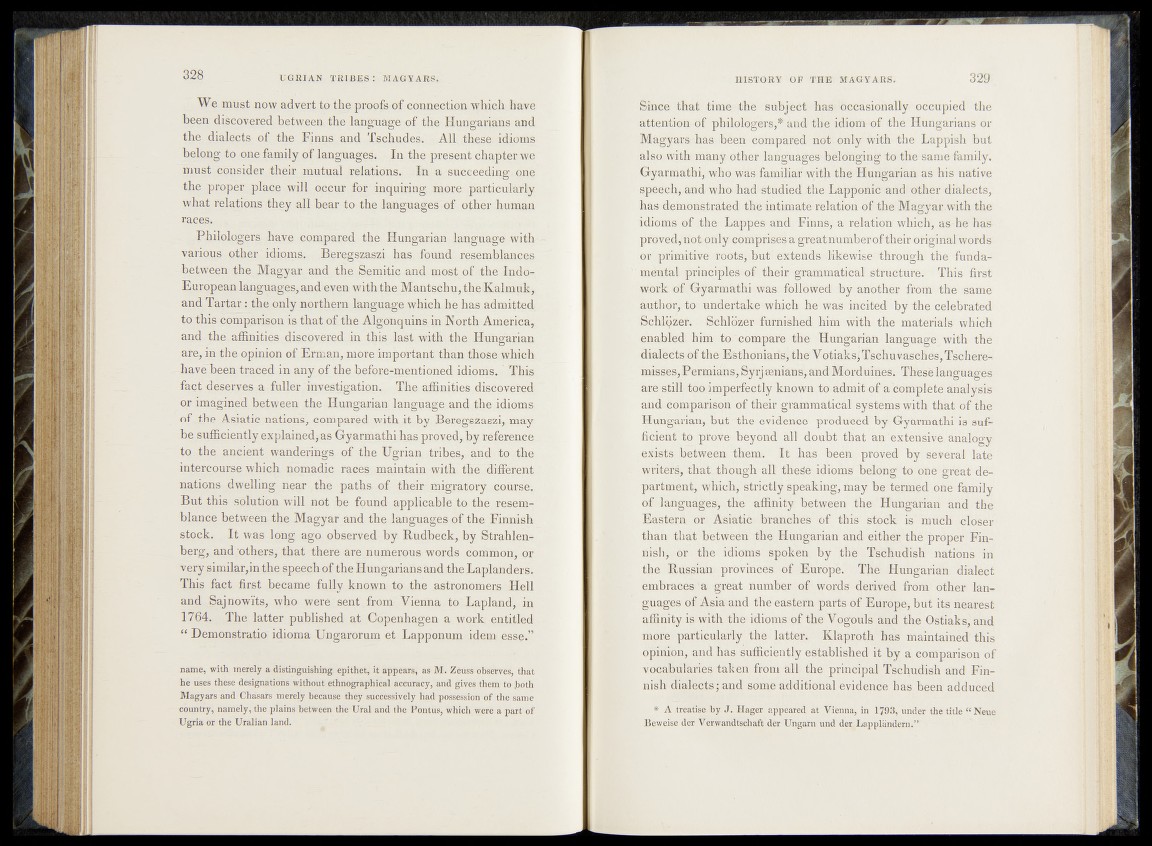
We must now advert to-t^e proofs of connection which have
been discovered between, the language of the Hungarians and
the dialects of, the Finns and Tschudesi , All, these idioms
belong to one family of languages. In the present chapter we
must consider their mutual relations. In a succeeding on©
the proper place.will occur for inquiring,more particularly
what relations^ they all bear-to the languages' of other human
races.
Philologers have compared fheiHungarian language' with'
vario,us other ' idipnp, . .Beregszaszi has. found .resemblances
between the Magyar, and the Semitic and^most pf the Jndon
European languages,and even with the Mantscbu,theKalmuk,
and T artar: the only northern language whichJ^e-has admitted
tc th is comparison is that of the Algonquins.in.$orth America,
and the affinities discoveredjn this last with the Hungarian
are, in the opinion of Erman, more important than jth&se which
have been traced in any of the before-mentionedddioms.' This
fact deserves a fuller investigation. The afhmtus^discov erod
or imagined,between -the Hungarian langiyqig1e..aiicLA^gidiom>
o k jh e Asiatic nations, compared with it by ,Her(egsigs^h,may'
be sufficiently explained^as Gyarmathi has proved,,by reference
to thg. pn^ient wanderings o f the Ugrian ta baka, and $ to the
intercourse which nomadic races maintain with tbe^lfferent
nations dwelling near the paths of their migratory, 'coursje^
But this solution will not be found applicable to the^esena^
blanee between the Magyar and the languages of the Finnish
stock. It was long ago observed by Rudbeck, by Strahlen-
berg, and .others, that there are numerous words common, or
very similar,in the speech of the Ilungariansand the Laplanders.
This fact first became fully known to the astronomers Hell
and Saj nowits, who were sent from Vienna to,'„Lapland, in
1764. The latter published atr.Copenhagen a work entitled
“ Demonstratio idioma Ungarorum et Lapponum idem essp/£
name, with merely a distinguishing epithet, it appears, as M. Zetrss observes, that
hie rises these designations without ethnographical accuracy, and gives them to jDoth
Magyars and Chasats merely because they successively had possession of the same
country, namely, the plains between the Ural and the Pontus, which_were a part of
Ugria or the Uralian land.
Since that time the subject has occasionally occupied the
attention of philologers,* and the idiom of the Hungarians or
Magyars:;has been compared not only With the Lappish but
also with many other labgiia^ës^belonging to the same family.
Gyarmathi, who was familiar with the Hungarian as his native
Speech, and who had'studied the Lapponic and' other dialects,
has demonstrated the intimawrelaffbn of the Magyar with the
idi<3U3>s;)©f -fithe Lappes arid: Finnsy a*, relation which, as he has
pro ved^nof onlyacomprises a*great numbér-of their original words
or! primitive.^roots,'ïb'uti extends -likewise? through the funda4
méntal prineiplesmhtheir< gramhiatifeal structure. This first
work off Gyarmathi was followed by another from the same
autho^ toy undertake winch he was incited by the celebrated
Jlghlqzer. ScMowerAfurnished him with the materials which
enabled him to~compare the Hungarian language^ with thé
dialects of the Rsthoniaris,:the Votiaks^Tschuvasches,Tschere->
misseSjPermians, Syrj seniairs, and Morduiriesi These languagès
arèfritilk too.imperfectly known to admit of a complete analysis
and Comparison of their grammatical systems with that of the
Hungarian^ hut the'evidencfet' produced by Gyarmathi is sufficient
to prove’ beyond all doubt that an extensive, analogy
exists^bkèween them': I t has been proved by several late
writers, that though aïl theëe idioms belong to one great department,
which, strictly speaking, may he termed one family
of language's, the affinity between - Hungarian and the
Eastern or Asiatic branches of this stock isf;mueh closer
than that between the Hungarian and either the proper Finnish,
or the idioms spoken by the Tschudish nations in
the Russian provinces of Europe. The Hungarian dialect
embraces la great number of words derived from other languages
of Asia and thé eastern parts of Europe, but its nearest
affinity is with the idioms of the Vogouls and the Ostiaks, and
more particularly the latter* Klaproth has maintained this
opiriion, and has sufficiently established it by a comparison of
vocabularies taken from all the principal Tschudish and Finnish
dialects; and saffie additional evidence has been adduced
* A treatise by J . Hager appeared at Vienna, in 1793, under the title “ Neue
Beweise der Verwandtschaft der Ungarn and de&Lapplandem.’’